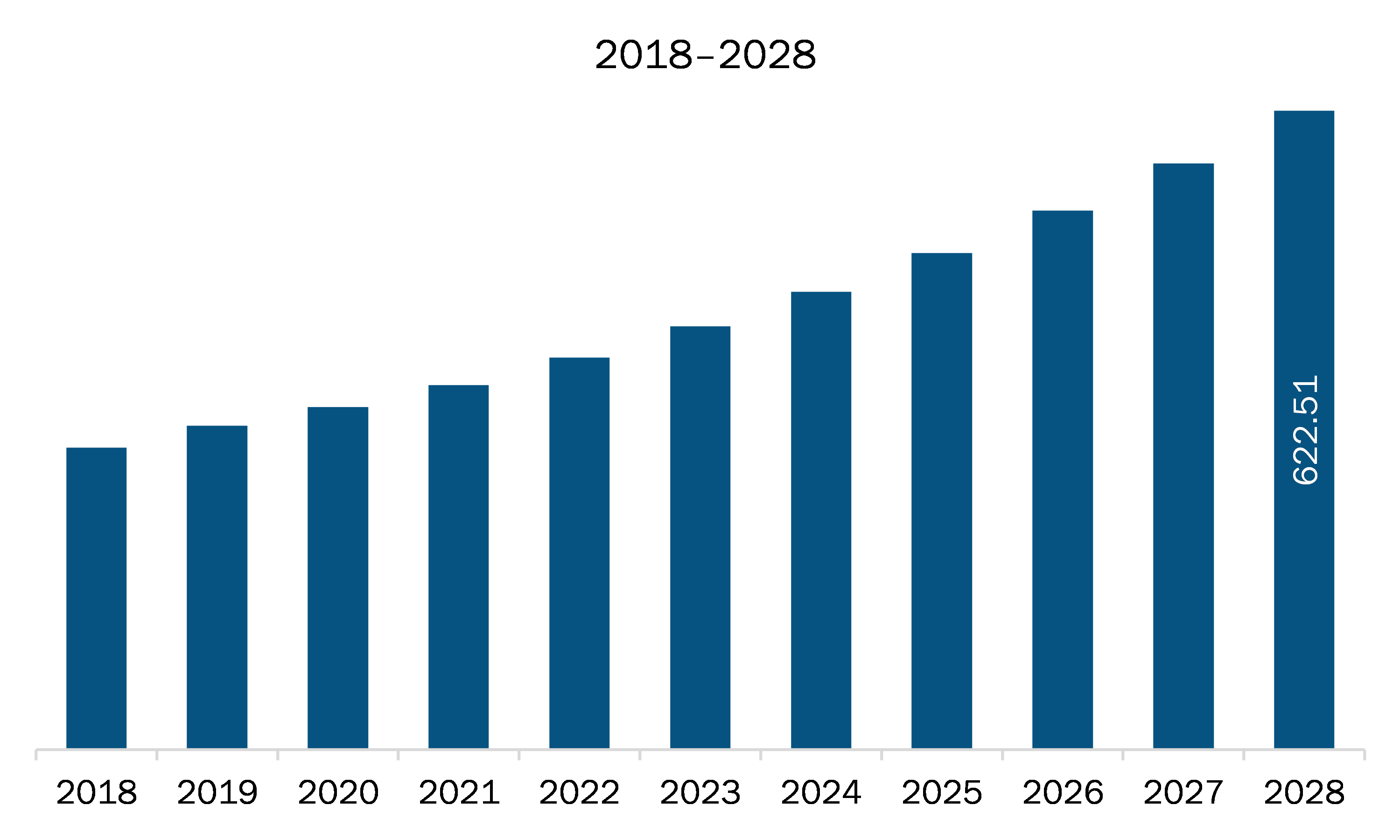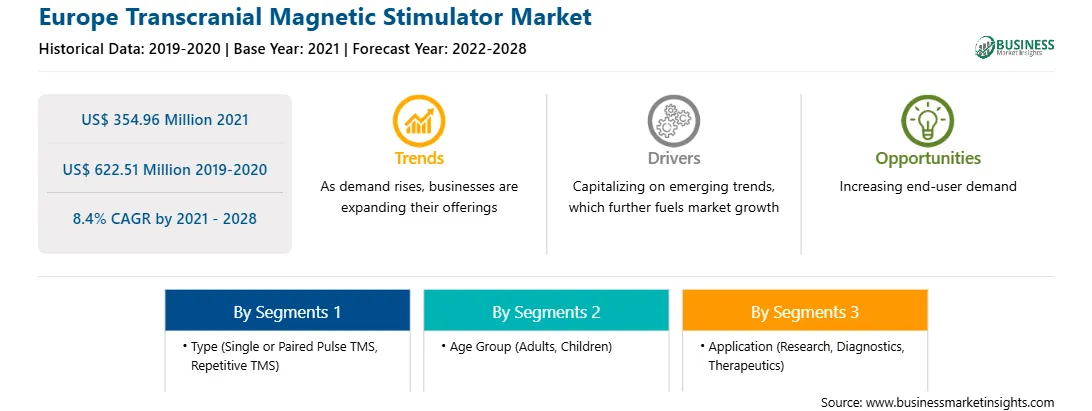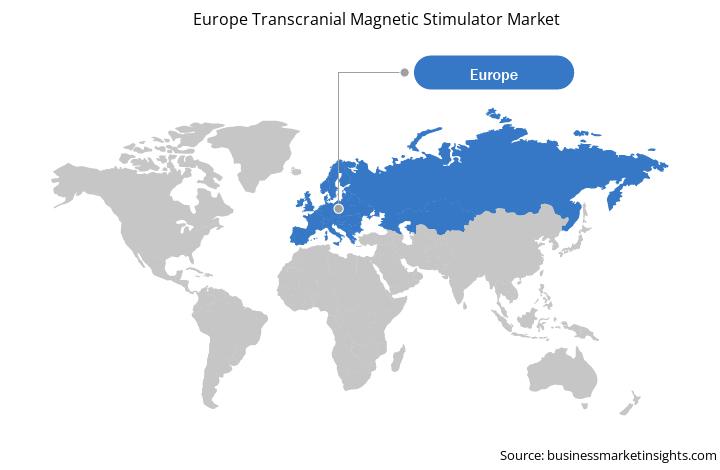The transcranial magnetic stimulator (TMS) market in Europe includes France, Germany, Italy, Spain, the UK, and the Rest of Europe. Rising prevalence of neurological disorders including schizophrenia and other disorders, surging geriatric population leading to increasing brain disorders associated with age the prime reasons that drives the growth of transcranial magnetic stimulator (TMS)s market. The rest of Europe in the Transcranial Magnetic Stimulator (TMS) market comprises Switzerland, Netherlands, Ireland, Belgium, Denmark, and other countries. The overall numbers of people with dementia will more than double from 137,344 in 2018 to 309,386 in 2050. Similarly, as a percentage of the overall population, people with dementia will represent 3.15% in 2050 compared to 1.62% in 2018. Switzerland exceeds the broader European trend of the numbers of people with dementia almost doubling by 2050. A key factor in this change appears to be the significant increase in the numbers of people aged over 65, and the over 85 age range, which almost triples between 2018 and 2050. Rise in prevalence of dementia will further drive the adoption of TMS in the review period.
In Europe, the COVID-19 pandemic has highly affected countries such as Italy, Spain, France, UK, and Russia. The number of positive cases has grown exponentially across the countries. The outbreak has significantly impacted the medical device industry in Europe. Various “notified bodies” for the medical device industry have restricted or discontinued their activities, to redirect their focus on COVID-19. Manufacturing companies and suppliers have lower down their production, which is hampering the demand and supply chains. The pandemic has also affected preparations for the upcoming EU Medical Device Regulation (2017/745) (MDR). It has disturbed the frameworks and guidelines meant for the medical device manufacturers, while the release dates of several regulations release have been postponed. In March 2020, the European Commission released a new date for introducing the Medical Device Reporting (MDR) application, postponing it to May 2021 from May 2020. Also, the government has shifted to focus on the production of personal protective equipment. These conditions have resulted in the deceleration of the Europe transcranial magnetic stimulator market growth.

Strategic insights for the Europe Transcranial Magnetic Stimulator provides data-driven analysis of the industry landscape, including current trends, key players, and regional nuances. These insights offer actionable recommendations, enabling readers to differentiate themselves from competitors by identifying untapped segments or developing unique value propositions. Leveraging data analytics, these insights help industry players anticipate the market shifts, whether investors, manufacturers, or other stakeholders. A future-oriented perspective is essential, helping stakeholders anticipate market shifts and position themselves for long-term success in this dynamic region. Ultimately, effective strategic insights empower readers to make informed decisions that drive profitability and achieve their business objectives within the market.

| Report Attribute | Details |
|---|---|
| Market size in 2021 | US$ 354.96 Million |
| Market Size by 2028 | US$ 622.51 Million |
| Global CAGR (2021 - 2028) | 8.4% |
| Historical Data | 2019-2020 |
| Forecast period | 2022-2028 |
| Segments Covered |
By Type
|
| Regions and Countries Covered | Europe
|
| Market leaders and key company profiles |
The geographic scope of the Europe Transcranial Magnetic Stimulator refers to the specific areas in which a business operates and competes. Understanding local distinctions, such as diverse consumer preferences (e.g., demand for specific plug types or battery backup durations), varying economic conditions, and regulatory environments, is crucial for tailoring strategies to specific markets. Businesses can expand their reach by identifying underserved areas or adapting their offerings to meet local demands. A clear market focus allows for more effective resource allocation, targeted marketing campaigns, and better positioning against local competitors, ultimately driving growth in those targeted areas.

The transcranial magnetic stimulator market in Europe is expected to grow from US$ 354.96 million in 2021 to US$ 622.51 million by 2028; it is estimated to grow at a CAGR of 8.4% from 2021 to 2028. Transcranial Magnetic Stimulation method relies on electromagnetic induction utilizing an insulated coil placed over the patient's scalp. It is focused on the area of the brain believed to play a role in mood regulation for depression management. The combination of artificial intelligence (AI) innovates devices with invasive and noninvasive brain-computer interfaces. A few organizations such as Google, LLC; Facebook, Inc.; Defense Advanced Research Projects Agency (DARPA); and Kernel are investing their efforts in combining AI with medical devices to treat neurological disorders. For instance, in June 2019, the DARPA announced Next-Generation Nonsurgical Neurotechnology (N3) program. Through the program, the organization is looking forward to developing brain-machine interfaces (BMIs).
Europe transcranial magnetic stimulator market is segmented into type, age group, application, and country. Europe transcranial magnetic stimulator market based on the type was segmented into single or paired pulse TMS, repetitive TMS (rTMS). In 2020, the single or paired pulse TMS segment held the largest share of the market. The Europe transcranial magnetic stimulator market, by age group, is segmented into adults and children. The adults segment held the largest share of the market in 2020. The Europe transcranial magnetic stimulator market, by application, is segmented into research, diagnostic and therapeutic. The diagnostics segment held the largest share of the market in 2020. Based on country, the Europe transcranial magnetic stimulator market is segmented into France, Germany, Italy, Spain, UK, and rest of Europe. Germany held the largest market share in 2020.
A few major primary and secondary sources referred to for preparing this report on the transcranial magnetic stimulator market in Europe are company websites, annual reports, financial reports, national government documents, and statistical database, among others. Major companies listed in the report are eNeura Inc.; MAG & More GmbH; Magstim; MagVenture, Inc.; Neurosoft; Nexstim; and REMED.
The Europe Transcranial Magnetic Stimulator Market is valued at US$ 354.96 Million in 2021, it is projected to reach US$ 622.51 Million by 2028.
As per our report Europe Transcranial Magnetic Stimulator Market, the market size is valued at US$ 354.96 Million in 2021, projecting it to reach US$ 622.51 Million by 2028. This translates to a CAGR of approximately 8.4% during the forecast period.
The Europe Transcranial Magnetic Stimulator Market report typically cover these key segments-
The historic period, base year, and forecast period can vary slightly depending on the specific market research report. However, for the Europe Transcranial Magnetic Stimulator Market report:
The Europe Transcranial Magnetic Stimulator Market is populated by several key players, each contributing to its growth and innovation. Some of the major players include:
The Europe Transcranial Magnetic Stimulator Market report is valuable for diverse stakeholders, including:
Essentially, anyone involved in or considering involvement in the Europe Transcranial Magnetic Stimulator Market value chain can benefit from the information contained in a comprehensive market report.